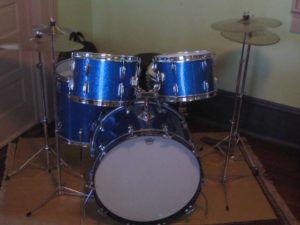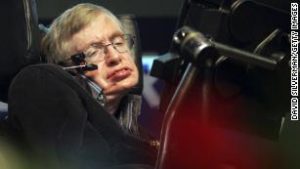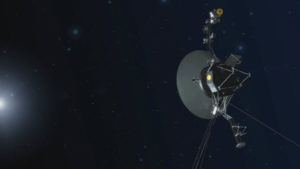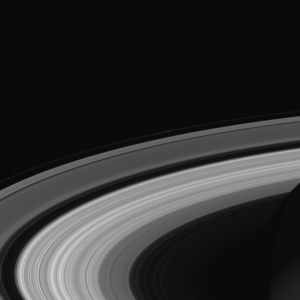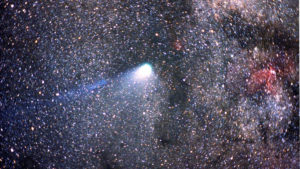The Loyal Engineers Steering NASA’s Voyager Probes Across the Universe
New York Times, Aug. 3, 2017
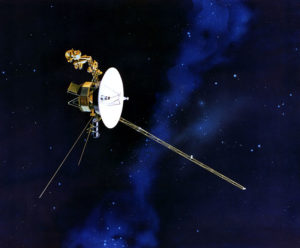
Good long feature in the New York Times about what remains of the 1970s Voyager Mission, the one that sent two probes, Voyager I and II, to explore the outer planets of our solar system. Link above, text below.
The Voyager probes have since left the heliosphere and entered interstellar space, creaking along with ancient on-board computers that have 235,000 times less memory and 175,000 times less speed than your average smartphone.
The mission control team has shrunk to a staff of 9, most past retirement age, who work out of a small rental suite in Altadena. They’ve forgone promotions and better jobs to keep monitoring the spacecraft.
Both Voyager spacecraft carry the famous “Golden Record,” a gold-plated copper disc engraved with a wide variety of Earth images, sounds, and spoken and written messages. Included on the discs are sounds from nature, songs of birds and whales, greetings in 55 languages, and human sounds like footsteps and laughter. Plus, music by Bach, Mozart, Beethoven, Stravinsky, Blind Willie Johnson, and Chuck Berry, playing “Johnny B. Goode.”
Golden Record:
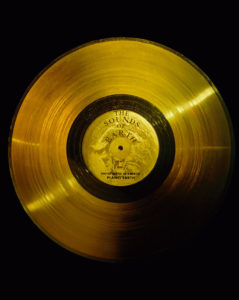
Golden Record Cover:
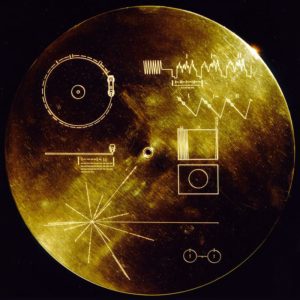
“Today the Voyagers are 10 billion and 13 billion miles away, the farthest man-made objects from Earth. The 40th anniversary of their launch will be celebrated next month.”
The Loyal Engineers Steering NASA’s Voyager Probes Across the Universe
As the Voyager mission is winding down, so, too, are the careers of the aging explorers who expanded our sense of home in the galaxy.
By KIM TINGLEYAUG
NYT, Aug. 3, 2017
In the early spring of 1977, Larry Zottarelli, a 40-year-old computer engineer at NASA’s Jet Propulsion Laboratory in Pasadena, set out for Cape Canaveral, Fla., in his Toyota Corolla. A Los Angeles native, he had never ventured as far as Tijuana, but he had a per diem, and he liked to drive. Just east of Orlando, a causeway carried him over the Indian and Banana Rivers to a triangular spit of sand jutting into the Atlantic, where the Air Force keeps a base. His journey terminated at a cavernous military hangar.
A fleet of JPL trucks made the trip under armored guard to the same destination. Their cargo was unwrapped inside the hangar high bay, a gleaming silo stocked with tool racks and ladder trucks. Engineers began to assemble the various pieces. Gradually, two identical spacecraft took shape. They were dubbed Voyager I and II, and their mission was to make the first color photographs and close-up measurements of Jupiter, Saturn and their moons. Then, if all went well, they might press onward — into uncharted territory.
It took six months, working in shifts around the clock, for the NASA crew to reassemble and test the spacecraft. As the first launch date, Aug. 20, drew near, they folded the camera and instrument boom down against the spacecraft’s spindly body like a bird’s wing; gingerly they pushed it, satellite dish first, up inside a metal capsule hanging from the high bay ceiling. Once ‘‘mated,’’ the capsule and its cargo — a probe no bigger than a Volkswagen Beetle that, along with its twin, had nevertheless taken 1,500 engineers five years and more than $200 million to build — were towed to the launchpad.
By T-minus two hours, a select few engineers, too nervous to sit down, stood at computers outside the high bay, overseeing the spacecraft telemetry. Elsewhere in the hangar, scientists, NASA brass from Washington and several dozen ‘‘nonessential’’ engineers — Zottarelli among them — huddled around TV monitors. At T-minus 30 seconds, the spacecraft’s engines roared to life, and many of the nonessentials took off running out of the room and toward the exit — ‘‘seven, six, five.’’ They burst out into the morning. Shielding their eyes, they peered across a flat expanse at smoke billowing on the horizon. Slowly and silently, the capsule rose out of the cloud, its rockets trailing flames. In an instant, there came a terrific boom as the sound waves from blastoff hit the hangar like a gong, ringing it as the spacecraft disappeared.
Two weeks later, after the second launch, everyone headed home. The show was over — both spacecraft were performing flawlessly — but behind the scenes, the mission, on a tight budget, lagged in hiring the more than 200 computer engineers needed to shepherd the spacecraft through a planetary encounter. Many of those on the flight team were fresh out of college, running the most sophisticated electronics systems in the world. They had barely had a chance to jell, when, in April 1978, not yet halfway to Jupiter, Voyager 1 experienced a problem. Its scan platform, where the cameras and instruments are mounted, got stuck.
As the engineers scrambled to figure out what they could do from more than 100 million miles away, someone forgot to send a weekly command to reset a timer on the other spacecraft. When it ran down without hearing from Earth, it triggered so-called fault-protection software, 600 lines of code that respond to malfunctions automatically. In this instance, fault protection assumed the radio receiver was broken and switched to the backup. On the mission-control monitors in a situation like this, the crawl of numbers reporting the status of the receivers would have turned crimson: a ‘‘red alarm.’’
Realizing their mistake, the engineers tried to stop the fault-protection routine, but the newly awakened backup receiver would not register their command. Helpless, they waited for the spacecraft to reason its way back to the original receiver; when it did, and the command went through normally, they were giddy with relief. They were still high-fiving when the working receiver shorted out like a blown fuse. Now it really was dead.
Fortunately, the malfunctioning backup receiver was still drawing current. They guessed that its oscillator, which allows it to accept a wide range of frequencies, had quit, essentially shrinking the target for transmissions from Earth. Assuming a much narrower bandwidth, and manually subtracting the Doppler effect, they recalibrated their signal. It worked — but to this day, the same calculation must precede every command. The original receiver remains useless: one engineer’s simple oversight nearly doomed humankind’s lone visit to Uranus and Neptune. ‘‘You like to think you have checks and balances,’’ Chris Jones, JPL’s chief engineer, who designed Voyager’s fault protection, told me. ‘‘In reality, we all worry about being that person.’’
Today the Voyagers are 10 billion and 13 billion miles away, the farthest man-made objects from Earth. The 40th anniversary of their launch will be celebrated next month. We tend to think of space as vacant, but it is actually matter, created, as everything in the universe is, by the explosions of ancient stars. Within our planetary neighborhood, this ‘‘space’’ is made up of different particles than the space outside is, because of supersonic wind that blows out from the surface of our sun at a million miles per hour. The wind generates a bubble around our solar system called the heliosphere. Five years ago, Voyager 1 reached the boundary where the heliosphere gives way to interstellar space, a region as novel to us — and potentially relevant — as the Pacific was to Europeans 500 years ago. The data the probes are collecting are challenging fundamental physics and will provide clues to the biggest of questions: Why did our sun give birth to life only here? Where else, within our solar system or others, are we most likely to find evidence that we are not alone?
The mission quite possibly represents the end of an era of space exploration in which the main goal is observation rather than commercialization. In internal memos, Trump-administration advisers have referred to NASA’s traditional contractors as ‘‘Old Space’’ and proposed refocusing its budget on supporting the growth of the private ‘‘New Space’’ industry, Politico reported in February. ‘‘Economic development of space’’ will begin in near-Earth orbit and on the moon, according to the president’s transition team, with ‘‘private lunar landers staking out de facto ‘property rights’ for Americans on the moon, by 2020.’’
All explorations demand sacrifices in exchange for uncertain outcomes. Some of those sacrifices are social: how many resources we collectively devote to a given pursuit of knowledge. But another portion is borne by the explorer alone, who used to be rewarded with adventure and fame if not fortune. For the foreseeable future, Voyager seems destined to remain in the running for the title of Mankind’s Greatest Journey, which might just make its nine flight-team engineers — most of whom have been with the mission since the Reagan administration — our greatest living explorers. They also may be the last people left on the planet who can operate the spacecraft’s onboard computers, which have 235,000 times less memory and 175,000 times less speed than a 16-gigabyte smartphone. And while it’s true that these pioneers haven’t gone anywhere themselves, they are arguably every bit as dauntless as more celebrated predecessors. Magellan never had to steer a vessel from the confines of a dun-colored rental office, let alone stay at the helm long enough to qualify for a senior discount at the McDonald’s next door.
Their fluency in archaic programming languages will become only more crucial as the years go on, because even as the probes harvest priceless information from the cosmos, they are running out of fuel. (Decaying plutonium supplies their power.) By 2030 at the latest, they will not have enough juice left to run a single experiment. And even that best case comes with a major caveat: that the flight-team members forgo retirement to squeeze the most out of every last watt.
One of the greatest obstacles to planetary science has always been the human life span: Typically, for instance, a direct flight to Neptune would take about 30 years. But in the spring of 1965, Gary Flandro, a doctoral student at Caltech, noticed that all four outer planets — Jupiter, Saturn, Uranus and Neptune — would align on the same side of the sun in the 1980s. If a spacecraft were launched in the mid- to late 1970s, it could use the gravity of the first body to slingshot to the second, and so on. Such a trajectory would add enough speed to shorten the total journey by almost two-thirds. What’s more, this orbital configuration would not appear again for 175 years.
The Voyagers carried cameras and instruments for analyzing atmospheric temperatures, moon masses, gravitational and magnetic fields and radiation levels. Reaching Jupiter in 1979, they captured images of lightning in its cloud tops and astounded scientists — who had assumed all moons were as barren as our own — with pictures of eight active volcanoes on its satellite Io; Europa, another Jovan moon, was encased in a shell of water ice, cracked in places by what appeared to be the tides of an ocean below. The photographs revealed themselves on control-room monitors pixel by pixel, row by row. ‘‘I would be sitting in here at night sometimes when the Voyager mission was flying,’’ Esker Davis, project manager for the Saturn encounter, told David W. Swift, who published an oral history of the mission in 1997, after Davis’s death. ‘‘And my wife would call up and ask what I was doing. I said, ‘Just watching pictures come in, being the first person to see this picture.’ ’’
The mission would have ended there, but President Ronald Reagan bestowed an extension, possibly swayed by the real-time briefings hosted by Ed Stone, the project’s lead scientist, on the occasion of every planetary encounter. Hundreds of reporters, as well as politicians and celebrities, attended, packing into a cramped JPL auditorium for the debuts of Uranus in 1986 and Neptune in 1989.
The final flyby, of Neptune’s moon Triton, took place on a hot August night. Afterward, everyone celebrated with Champagne, cold cuts and drunken singing; on the JPL lawn, Chuck Berry performed ‘‘Johnny B. Goode,’’ one of the tracks included on gold-plated records of human sights and sounds attached to the spacecraft for any intelligent life that might find them. Then, gradually, the hallways grew quiet. Stone and his colleagues moved on to new projects while analyzing Voyager data part time; the flight team laid off 150 engineers (many of whom went on to staff subsequent missions). The probes’ new goal was to reach interstellar space. But though scientists had measured the speed of the solar wind that forms the heliosphere, the properties of the matter beyond it had never been analyzed. How much pressure it exerted on the bubble, and thus the size of the bubble, were a mystery. So, too, was how long — years? decades? — it might take a craft to escape it.
At the mission’s outset, the flight-team members were mischievous kids. They relieved stress with games and pranks: bowling in the hallway, using soda cans as pins; filling desk drawers with plastic bags of live goldfish; making scientists compete in disco-pose contests. Now, by 1990, they were older, with kids of their own. They had experienced the deaths of colleagues and watched others’ marriages falter as a result of long hours at the lab. With no planets to explore, they spent the decade doing routine spacecraft maintenance with a fraction of their bygone manpower. Six of the current nine engineers were on the team then. Sun Kang Matsumoto, who joined the mission in ’85, studied so diligently to master the new roles pressed upon her that her sons learned the spacecraft contours by osmosis. When her eldest was 8, he surprised her with a perfect Lego model; now in college, ‘‘he calls and asks, ‘How is Voyager?’ Like, ‘How is Grandma?’ ’’ Matsumoto says.
The mission originally occupied three floors of Building 264 on the JPL campus, home to many of the lab’s highest-profile projects. But soon after Neptune, says Jefferson Hall, who joined the project in 1978, ‘‘we were booted out.’’ Their first move was into the former offices of a mainframe-computer company in Sierra Madre. In 2002, after more staff cuts, they moved to a rental suite in Altadena. NASA reviewed the mission to determine if it should be canceled altogether.
The scientists’ models, meanwhile, began to reveal subtle changes in the raw data. By late 2004, it was clear that Voyager 1’s magnetometer had detected an abrupt increase in the strength of the surrounding magnetic field, suggesting the probe had entered the outermost layer of the heliospheric bubble, the ‘‘heliosheath.’’ This is where the solar wind ions abruptly slow as they press outward against the surrounding interstellar matter and swerve to create a cometlike tail. A wind of interstellar ions flows around the outside of the bubble like water around the bow of a ship. Finally, on Aug. 25, 2012, the density of particles around the spacecraft precipitously increased, as though it had plunged from sky to sea. It had crossed the threshold of interstellar space.
In 2016, the year he turned 80, Zottarelli, the flight team’s most experienced programmer, gave six months’ notice and spent the time training a successor. None of the other engineers, only one of whom is under 50, have a replacement in waiting in the event that they abdicate more suddenly. Unlike the astrophysicists who devise experiments for Voyager and who interpret the results, the core flight-team members don’t have the luxury of being able to work simultaneously on other missions. Over decades, the crew members who have remained have forgone promotions, the lure of nearby Silicon Valley and, more recently, retirement, to stay with the spacecraft. NASA funding, which peaked during the Apollo program in the 1960s, has dwindled, making it next to impossible to recruit young computer-science majors away from the likes of Google and Facebook.
Last autumn, I drove through the San Gabriel Valley to a squat concrete building beside Scott-Fox Puppy Preschool. Suzanne Dodd, 56, the mission’s project manager, answered the door. She wore red-framed glasses over sharp blue eyes, and her fair hair was cut short. She escorted me past the vestibule to a common room ringed by office doors. Hanging over the cubicle partitions in the center was a shingle that read ‘‘Mission Control.’’
‘‘You can see where we are in the culture,’’ she said, with a mild sweep of her palm. Voyager was her first job. She pointed out a used microfiche reader that Tom Weeks, a hardware engineer and the self-described mission librarian, purchased on eBay to read old diagnostics reports. To conserve power on the spacecraft, the engineers must decide what to turn off when, and for how long — which means estimating how cold they can let each component get. (On Voyager 2, because of the broken oscillator, any change in temperature also tweaks the receiver frequency.) Turning the heaters off for a while is the safest way to get enough power to run the instruments, but the lower the overall wattage drops, the faster parts will freeze. One of the team’s most valuable insights so far: Spinning the wheels of an eight-track tape recorder — the spacecrafts’ only data-storage option — generates a bit of additional heat.
Enrique Medina, the power subsystem expert, was preparing to implement a ‘‘patch,’’ an update that would turn off a heater on Voyager 2 in order to run the gyroscope, roll the spacecraft and calibrate the magnetometer. Even though they simulate every patch with software, there is plenty of room for human error. Far more often, hardware fails for no evident reason. In 1998, Voyager 2 reacted to a command by going silent. For 64 hours straight, the flight team studied the specific instruction — consisting of 18 bits, or 1s and 0s — that preceded the blackout. Bits have been known to ‘‘flip’’ to the opposite value, changing the instruction the same way that swapping a single letter turns ‘‘cat’’ into ‘‘cut.’’ The question was: What instruction had they accidentally given and how could they undo it? At last, modeling the outcome of each possible bit, they discovered one that turned off the exciter, which generates the spacecraft’s radio signal; when they turned it back on, the transmissions resumed. A similar scare took place in 2010, when a bit involved in formatting telemetry flipped, turning the transmissions to gibberish. ‘‘A lot of our anomalies we’ve come up with workarounds for, and at the time we didn’t know why it happened,’’ Weeks explained. Dodd added, ‘‘The No. 1 rule with spacecraft is: Don’t change it if you don’t have to.’’
In the mission-control cubby, Medina, who is 68 and a grandfather of four, with a husky voice and a Tom Selleck mustache, rolled a chair over to two pairs of monitors labeled with construction-paper signs that read: ‘‘Voyager Mission Control Hardware, PLEASE DO NOT TOUCH.’’ He jiggled a mouse, and one of the screens woke to a stream of numbers and letters describing the health of Voyager 1.
Because they have only four kilobytes of computer storage, the spacecraft transmit data 24/7, but the radio signals take 19 hours and 12 hours to reach Earth. The three antenna dishes big enough to register them are shared, so Voyager gets only four to six hours of reception time per spacecraft per day; outside these often odd windows, their data dissipate into the ether. Medina gestured to another computer in the corner that monitors the telemetry that comes in when the office is empty and, if it detects an anomaly, phones an on-call engineer: the Voyager Alarm Monitor Processor Including Remote Examination tool. ‘‘We call it Vampire,’’ Medina said, ‘‘because it works in the middle of the night.’’
In March 2014, after news broke that Voyager 1 had crossed into interstellar space, I spoke with Medina over the phone. ‘‘I would not leave my wife to go with Angelina Jolie, as exciting as that sounds,’’ he told me. ‘‘And I would not leave Voyager to go to the new Mars missions. I will not leave Voyager until it ceases to exist. Or until I cease to exist.’’
All the billions of stars in the universe, hosts to billions of planets, have a heliosphere. Understanding the properties of our own will help us interpret observations of those systems. Voyager 1 has shown that it blocks 75 percent of cosmic radiation, which at extreme levels is toxic to life as we know it. This is not a static number: Our sun is orbiting the galaxy at 125 miles per second; its interstellar environment — and thus the size and shape of its heliosphere — is constantly in flux.
‘‘If the pressure outside got high enough, and there are some areas in the Milky Way galaxy where it would be high enough, it could compress the heliosphere down to where in fact the boundary is almost to where we are. And that would change the radiation environment of the planets, which is important when you want to try to understand anything about the origin of life,’’ Ed Stone, the science-team leader, told me when I visited him at Caltech last fall. ‘‘Here on Earth, wherever there’s liquid water, whether it’s boiling water coming out of the vents or frozen water, there are microbes there. So life is remarkably robust where there’s water.’’
He went on: ‘‘I think that one of the biggest questions is, Can we find a spot here in the solar system where there’s microbial life? If there’s no microbial life anywhere else, that would be surprising, given here on Earth it appeared fairly quickly after the end of the bombardment,’’ an epic rain of asteroids some four billion years ago. ‘‘If one could ever find some evidence of it here in the solar system where we could get a sample, then one could look at the DNA. All life on Earth has a related DNA. Is that true for everywhere? Either answer would be amazing. Either there’s only one way that life evolves, or no, there’s more than one way.’’
In his office, Stone stood on tiptoe to lift an intricate model of Voyager from the top of a bookcase. At 81, he moves more stiffly than the Stone of NASA archival footage. Otherwise, he is remarkably unchanged. On a bulletin board behind his computer, he pins the latest graphs of the rate of charged particles that each spacecraft has detected. A drastic dip in low-energy ones is what convinced him that Voyager 1 had exited the heliosphere, and he is eager for Voyager 2, which entered the heliosheath from a different angle in 2007, to see a comparable drop before it goes quiet.
‘‘When we started this, I realized we were on a mission of discovery,’’ he said. ‘‘I just had no idea how much discovery there was going to be. And I certainly had no idea that it would last as long as it has.’’ After we lose contact with them, the spacecraft will continue to orbit the galaxy for billions of years, never striking another star. ‘‘Space,’’ Stone said, ‘‘is really empty.’’
Astrophysicists who study the heliosphere wage a constant battle against apathy when it comes to invisible substances nearly 100 times farther away from us than the sun is. ‘‘I hear a lot of people saying, ‘So what?’ I try to explain: ‘It’s like your home,’ ’’ Merav Opher, a professor of astrophysics at Boston University and a member of the Voyager science team, told me. ‘‘You just found out the walls aren’t walls. They’re porous. I think it’s existential.’’ In 2006, Opher and Stone published a landmark paper in The Astrophysical Journal predicting that Voyager 2 would encounter the heliosphere boundary closer to the sun than its twin had, pointing to a startling contradiction: The heliosphere must be asymmetrical; it is not a ‘‘sphere’’ after all.
There is passionate disagreement about what its exact shape is. (The Voyager scientists argue over practically every scrap of data; a few holdouts insist that Voyager 1 has yet to reach interstellar space.) In 1961, Eugene Parker, the renowned astrophysicist who first predicted the existence of a heliosphere, hypothesized that it might look like a comet — compressed in front with a tail in back. Earlier this year, Tom Krimigis, the emeritus head of the Applied Physics Laboratory at Johns Hopkins University and the principal investigator for Voyager’s Low-Energy Charged Particle Experiment, published a paper in Nature Astronomy showing that the heliosphere has a very short tail and ‘‘kind of moves through space like a clenched fist.’’ His instrument has also shown that cosmic rays — expected to flow toward the heliosphere uniformly from across interstellar space — actually move quite differently depending on their orientation to the interstellar magnetic field. ‘‘Every once in a while, a tsunami passes Voyager,’’ Krimigis told me, referring to these waves. ‘‘The galaxy was supposed to be a calm sea, and that’s not what we find.’’
Opher believes that the influence of the sun’s magnetic field may warp the heliosphere into the shape of a ‘‘croissant.’’ At its plump center, interstellar matter presses in closer than previously thought — which would mean we are less isolated from the rest of the galaxy than we believe.
Last Sept. 29, a Thursday, Larry Zottarelli awoke before 7, as he did most weekdays, and dressed quietly so as not to disturb his sleeping wife. He raked a comb through his silver hair, donned trifocals and a calculator watch and drove to the office. He brewed his first mug of coffee in the efficiency kitchen and carried it to his desk. He’d been on the job for 40 years; the next day would be his last. A printed-out email taped to his computer hutch had instructions for handing in his badge and parking pass and collecting his final paycheck. He had cleared out most of his belongings, except two gallon-size Ziploc bags, in which he had sealed the plastic arms of his office chair to protect them from disintegrating under the daily weight of his elbows. Sitting facing the door, backed by a windowless, conch-pink brick wall, he brought to mind a hermit crab wearing a seashell.
Later that morning, when Zottarelli entered the conference room to attend his last daily flight-team briefing, his colleague Adans Ko, 58, was arranging takeout containers of dim sum on the table for a celebration. He threw an arm around his shoulders and said, ‘‘Larry is going to give me a kiss today!’’ Matsumoto, who was holding a camera, said, ‘‘O.K., look at me.’’ She was making a photo album for him. When the party broke up, I found Zottarelli’s replacement, Lu Yang, at her desk. I asked her if he had given her any specific advice. ‘‘Whatever the problem, you go there and solve it,’’ she said, and laughed.
In retirement, Zottarelli told me, he would like to see Florida again. He wonders how it has changed. In his garage is a 1954 Swallow Doretti, a fixer-upper. ‘‘It probably needs new brakes,’’ he said. I asked him if there was anywhere he liked to drive for fun. ‘‘No,’’ he replied. ‘‘Not anymore.’’
I had stopped by his office to say goodbye and ask him what he planned to do with his newfound freedom. I pictured him in the Doretti, flying down the Pacific Coast Highway, wind in his hair. But he seemed to be in no mood for talking. I wished him well and turned to go. Then he spoke. ‘‘I expect my second stroke will be on the 17th of November,’’ he said ruefully, gesturing toward his empty wall calendar. ‘‘Life expectancy is five to seven years at my age on retiring, so —’’ He paused. ‘‘That was humor, I guess. I’m not looking forward to being even older. Got no choice in the matter.’’
I asked if he ever found himself thinking about the billions of years that the Voyagers will circle the center of the galaxy, long after our sun has exploded, scattering more stardust throughout the universe. ‘‘Of course,’’ he said. ‘‘I was raised in the Roman Rite. I’m pretty much an atheist. But what is the meaning of life? It’s not Monty Python, O.K.?’’
Had he reached any conclusions about what it is? ‘‘Well, on Earth, yeah,’’ he said. ‘‘One species always prepares the way for the next generation — that’s all.’’
* * *


